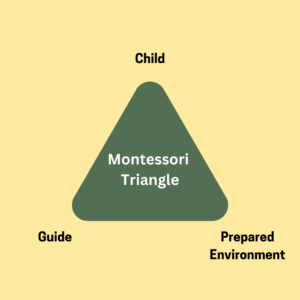
In the past, education often involved a one-way relationship where children were passive learners, expected to follow adult instructions without much opportunity for independent action. This approach limited their spontaneity and self-motivation. Montessori education, however, emphasizes the importance of creating an environment that allows children to engage actively and develop their own abilities. This is known as the child’s “self-learning ability.”
The Montessori Triangle
The Montessori triangle consists of three elements: the child, the environment, and the adult. The role of the adult is to create an environment where the child can explore and learn independently. The child interacts with this environment to develop their skills and understanding, while the adult supports and guides the child’s engagement.

Presenting the Tools
Even with a well-prepared environment, children might not know how to interact with it. Adults should understand the purpose of each material and demonstrate its use. This process, known as “presenting,” helps children understand how to use the materials effectively and engage with their environment. Learn more about how to properly present Montessori materials in this blog post.
Creating the Right Environment
Once you’ve observed your child’s developmental stages and sensitive periods, you can tailor their environment accordingly. In Montessori, it’s not just about attractive shelves and fancy toys; it’s about creating an environment that supports your child’s specific developmental needs. For instance, if your child is practicing pincer grasps, provide activities that enhance this skill.
The Difference Between Materials and Toys
- Toys are primarily for entertainment.
- Materials are designed to promote growth and development.
Even handmade materials, when created with the intention of fostering growth, differ from toys in that they have a clear developmental purpose.
Five Key Points for Making Montessori Materials
- Attractiveness:
- Use colors like red, blue, yellow, and pastels.
- Incorporate real, natural materials to engage the five senses.
- Avoid unnecessary decorations that distract from the tool’s purpose.
- Child-Sized:
- Ensure the size, weight, and strength of tools and furniture are appropriate for children.
- This makes it easier for children to use them independently.
- Repeatability:
- Create tools that encourage repetition until the child is satisfied.
- Incorporate self-correction mechanisms so children can recognize and correct their own mistakes.
- Simplicity:
- Focus on a single task to maintain interest and concentration.
- Avoid overcomplicating tools with multiple tasks.
- Developmental Potential:
- Once a child masters an activity, provide a more advanced version.
- For example, after mastering basic tong use, introduce smaller objects to pinch with tweezers.
Three Types of Isolation
- Sensory Isolation:
- Focus on one of the five senses by minimizing the others.
- Example: Use a noise tube to focus on hearing by making the contents invisible.
- Isolation of Properties:
- Emphasize a single property (e.g., color, shape) to help the child focus.
- Example: Use cups of different colors but the same shape and material to focus on color matching.
- Isolation of Difficulty:
- Break down activities into simpler components to practice the difficult parts separately.
- Example: Practice button fastening separately from dressing to focus on mastering the buttoning skill.
By understanding these principles, you can create effective Montessori teaching tools that support your child’s development during their sensitive periods. This approach not only fosters independence but also helps cultivate a sense of accomplishment and self-affirmation in children.


2 thoughts on “How To Create the Right Montessori Environment”